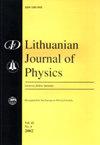Effect of spring grass fires on indoor air quality in air-conditioned office building
IF 0.3
4区 物理与天体物理
Q4 PHYSICS, MULTIDISCIPLINARY
引用次数: 1
Abstract
Open biomass burning (OBB) is a significant air pollution source, but it is still not clear to what extent OBB events affect indoor air quality [1]. Outdoor and indoor measurements of submicron particulate matter (PM1) were conducted on 25–29 April (2019) in the capital city Vilnius (Lithuania). Fires from neighbouring countries (Belarus, Ukraine and Russia) and in the vicinity of Vilnius broke out during the measurement campaign. The temporal evolution and transport of OBB plume were investigated by combining the air mass backward trajectory analysis and fire satellite observation (MODIS) database. Measurements of the PM1 chemical composition in real-time were performed using an aerosol chemical speciation monitor (ACSM) and an aethalometer. Organic matter was the clearly dominant component, accounting for >70%, in both indoor and outdoor PM1. The air filtering system of the office building removed approximately up to 55% of PM1. Despite a significantly lower PM1 pollution level in the office, highly acidic indoor PM1 could have harmful effects on the human health. Source apportionment of particulate carbonaceous matter revealed a significant importance of OBB-related particles (average 56%) to indoor air.春季草地火灾对空调办公楼室内空气质量的影响
露天生物质燃烧(OBB)是一个重要的空气污染源,但OBB事件对室内空气质量的影响程度尚不清楚。2019年4月25日至29日,在立陶宛首都维尔纽斯进行了亚微米颗粒物(PM1)的室外和室内测量。在测量运动期间,邻国(白俄罗斯、乌克兰和俄罗斯)和维尔纽斯附近发生了火灾。结合气团反轨迹分析和卫星观测(MODIS)数据库,研究了OBB羽流的时空演变和输运。使用气溶胶化学形态监测仪(ACSM)和酒精计对PM1化学成分进行实时测量。在室内和室外的PM1中,有机质都是明显的优势成分,占70%。办公楼的空气过滤系统去除了大约55%的PM1。尽管办公室的PM1污染水平明显较低,但高酸性的室内PM1可能对人体健康产生有害影响。颗粒碳质物质的源解析显示obb相关颗粒对室内空气的重要性显著(平均56%)。
本文章由计算机程序翻译,如有差异,请以英文原文为准。
求助全文
约1分钟内获得全文
求助全文
来源期刊

Lithuanian Journal of Physics
物理-物理:综合
CiteScore
0.90
自引率
16.70%
发文量
21
审稿时长
>12 weeks
期刊介绍:
The main aim of the Lithuanian Journal of Physics is to reflect the most recent advances in various fields of theoretical, experimental, and applied physics, including: mathematical and computational physics; subatomic physics; atoms and molecules; chemical physics; electrodynamics and wave processes; nonlinear and coherent optics; spectroscopy.
 求助内容:
求助内容: 应助结果提醒方式:
应助结果提醒方式:


